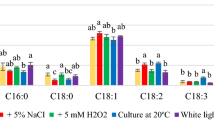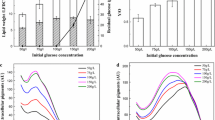Abstract
The effect of H2O2 supplement on cell growth and β-carotene productions in recombinant Saccharomyces cerevisiae CFW-01 and CFW-01 ctt1 deficiency in cytosolic catalase were investigated in shaking flasks. The results showed that supplement of H2O2 (0.5 and 1.0 mM) can significantly stimulate the β-carotene production. However, β-carotene levels of CFW-01 ctt1Δ under 0.5 and 1 mM H2O2 were 16.7 and 36.7% lower than those of CFW-01, respectively. Although lacking cytosolic catalase, no significant differences in cell growth were observed between CFW-01 ctt1Δ and CFW-01 under the same level of H2O2 stress. These results suggest that β-carotene can act as an antioxidant to protect the recombinant yeast from H2O2 oxidative damage in the absence of cytosolic catalase. However, catalase still plays an important role in the production of β-carotene under H2O2 stress. If catalase can not timely decompose H2O2, the free radicals such as OH· derived from H2O2 can result in decrease of β-carotene concentration. Therefore, in the production of β-carotene by H2O2 stress, not only the level of oxidative stress, but also the activities of catalase in cells should be considered.




Similar content being viewed by others
References
Bradford M (1976) A rapid and sensitive method of the quantification of microgram quantities of protein using the principle of protein-dye binding. Anal Biochem 72:248–255
Burke D, Dawson D, Stearns T (2000) Methods in yeast genetics. Cold Spring Harbor Laboratory Press, Cold Spring Harbor
Georgiou DC, Tairis N, Polycratis A (2001) Production of β-carotene by Sclerotinia sclerotiorum and its role in sclerotium differentiation. Mycol Res 105:1110–1115
Guldener U, Heck S, Fielder T et al (1996) A new efficient gene disruption cassette for repeated use in budding yeast. Nucleic Acids Res 24:2519–2524
Huan XU, Yuan QP (2007) Catalase plays an anti-oxidant role in Blakeslea trispora. Liquor Mak 34:54–56
Iigusa H, Yoshida Y, Hasunuma K (2005) Oxygen and hydrogen peroxide enhance light-induced carotenoid synthesis in Neurospora crassa. FEBS Lett 579:4012–4016
Izawa S, Inoue Y, Kimura A (1996) Importance of catalase in the adaptive response to hydrogen peroxide: analysis of acatalasaemic Saccharomyces cerevisiae. Biochem J 320:61–67
Jamieson DJ (1998) Oxidative stress responses of the yeast Saccharomyces cerevisiae. Yeast 14:1511–1527
Jeong JC, Lee IY, Kim SW et al (1999) Stimulation of β-carotene synthesis by hydrogen peroxide in Blakeslea trispora. Biotech Lett 21:683–686
Kim SW, Sco WT, Park YH (1997) Enhanced synthesis of trisporic acids and β-carotene production in Blakeslea trispora by addition of non-ionic surfactant, Span 20. J Ferment Bioeng 84:330–332
Lushchak VI, Gospodaryov DV (2005) Catalases protect cellular proteins from oxidative modification in Saccharomyces cerevisiae. Cell Biol Int 29:187–192
Mathews-Roth MM (1984) Porphyrin photosensitization and carotenoid protection in mice; in vitro and in vivo studies. Photochem Photobiol 40:63–67
Misawa N, Shimada H (1998) Metabolic engineering for the production of carotenoids in non-carotenogenic bacteria and yeasts. J Biotech 59:169–181
Mishra S, Panjwani D, Mishra B et al (2010) Effect of excess nickle on induction of oxidative stress in Zea mays L. plants grown in solution culture. Int J Toxicol Pharm Res 2:10–16
Moore MM, Breedveld MW, Autor A (1989) The role of carotenoids in preventing oxidative damage in the pigmented yeast, Rhodotorula mucilaginosa. Arch Biochem Biophys 270:419–431
Nanou K, Roukas T (2009) Oxidative stress response and morphological changes of Blakeslea trispora induced by butylated hydroxytoluene during carotene production. Appl Biochem Biotechnol 10.1007/s12010-009-8712-y
Nanou K, Roukas T, Kotzekidou P (2007) Role of hydrolytic enzymes and oxidative stress in autolysis and morphology of Blakeslea trispora during β-carotene production in submerged fermentation. Appl Microbiol Biotechnol 74:447–453
Piegeolet E, Corbisier PG (1990) Px, SOD and catalase inactivation by AO. Mech Age Dec 51:283–297
Verduyn C, Postma E, Scheffers WA et al (1992) Effect of benzoic acid on metabolic fluxes in yeast: a continuous-culture study on the regulation of respiration and alcoholic fermentation. Yeast 8:501–517
Verwaal R, Wang J, Meijnen JP et al (2007) High-level production of Beta-carotene in Saccharomyces cerevisiae by successive transformation with carotenogenic genes from Xanthophyllomyces dendrorhous. Appl Environ Microbiol 73:4342–4350
Weitberg AB, Weitzman SA, Clark EP et al (1985) Effects of antioxidants on oxidant-induced sister chromatid exchange formation. J Clin Invest 75:1835–1841
Yan GL, Hua ZZ, Du GC et al (2006) Adaptive response of Bacillus sp. F26 to hydrogen peroxide and menadione. Curr Microbiol 52:238–242
Yoon SH, Lee SH, Das A et al (2009) Combinatorial expression of bacterial whole mevalonate pathway for the production of β-carotene in E. coli. J Biotech 140:218–226
Yuan LZ, Rouviere PE, Robert A et al (2006) Chromosomal promoter replacement of the isoprenoid pathway for enhancing carotenoid production in E. coli. Metab Eng 8:79–90
Acknowledgments
This research was supported by grants from the National High Technology Research and Development Program of China (863 Program) (No 2007AA10Z341) and National Natural Science Foundation of China (No 31000811/C200207) and Open Project Program of State Key Laboratory of Food Science and Technology in Jiangnan University. We also thank Dr Rene Verwaal in Netherland for his kindly providing the vector YIplac211 used in the experiment.
Author information
Authors and Affiliations
Corresponding author
Additional information
Heng-yu Liang has equally contributed to this work
Rights and permissions
About this article
Cite this article
Yan, Gl., Liang, Hy., Wang, Zq. et al. Important Role of Catalase in the Production of β-carotene by Recombinant Saccharomyces cerevisiae under H2O2 Stress. Curr Microbiol 62, 1056–1061 (2011). https://doi.org/10.1007/s00284-010-9826-8
Received:
Accepted:
Published:
Issue Date:
DOI: https://doi.org/10.1007/s00284-010-9826-8




